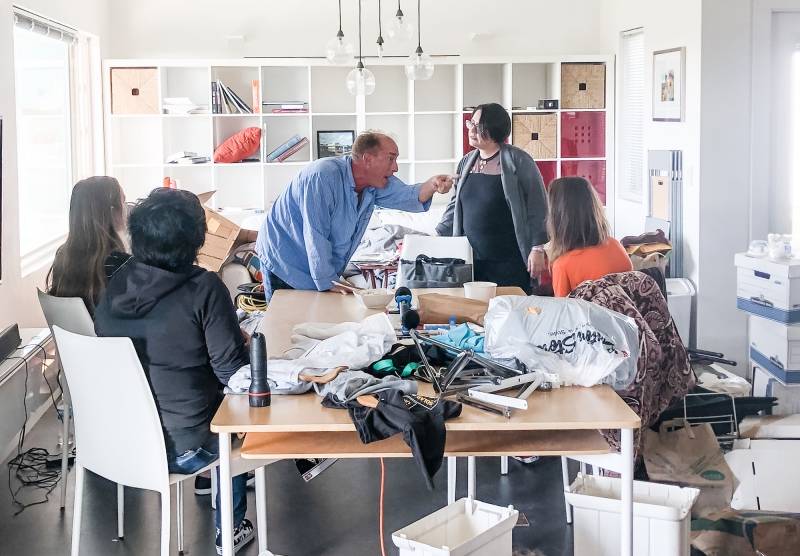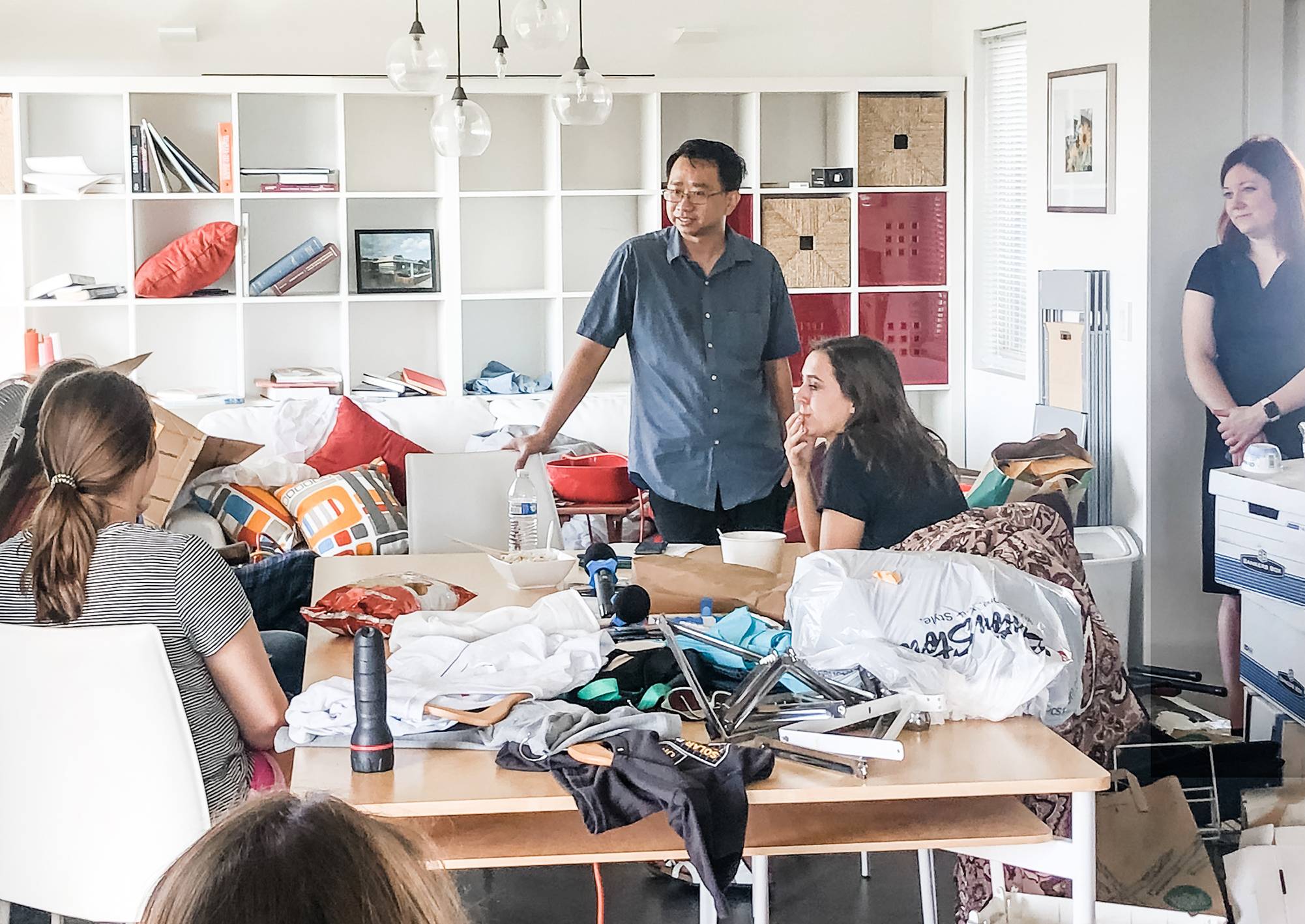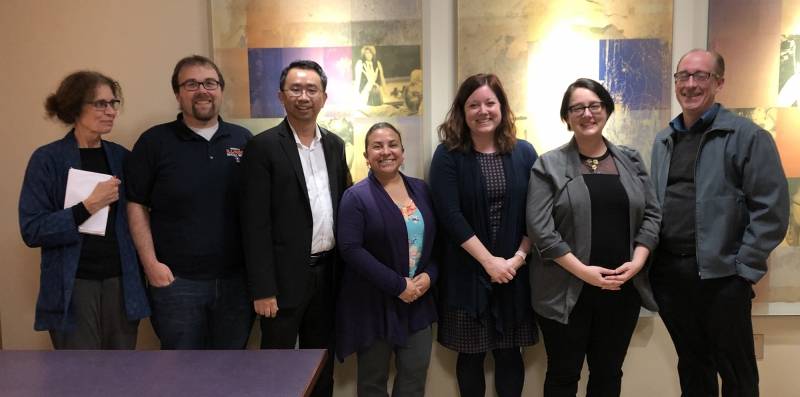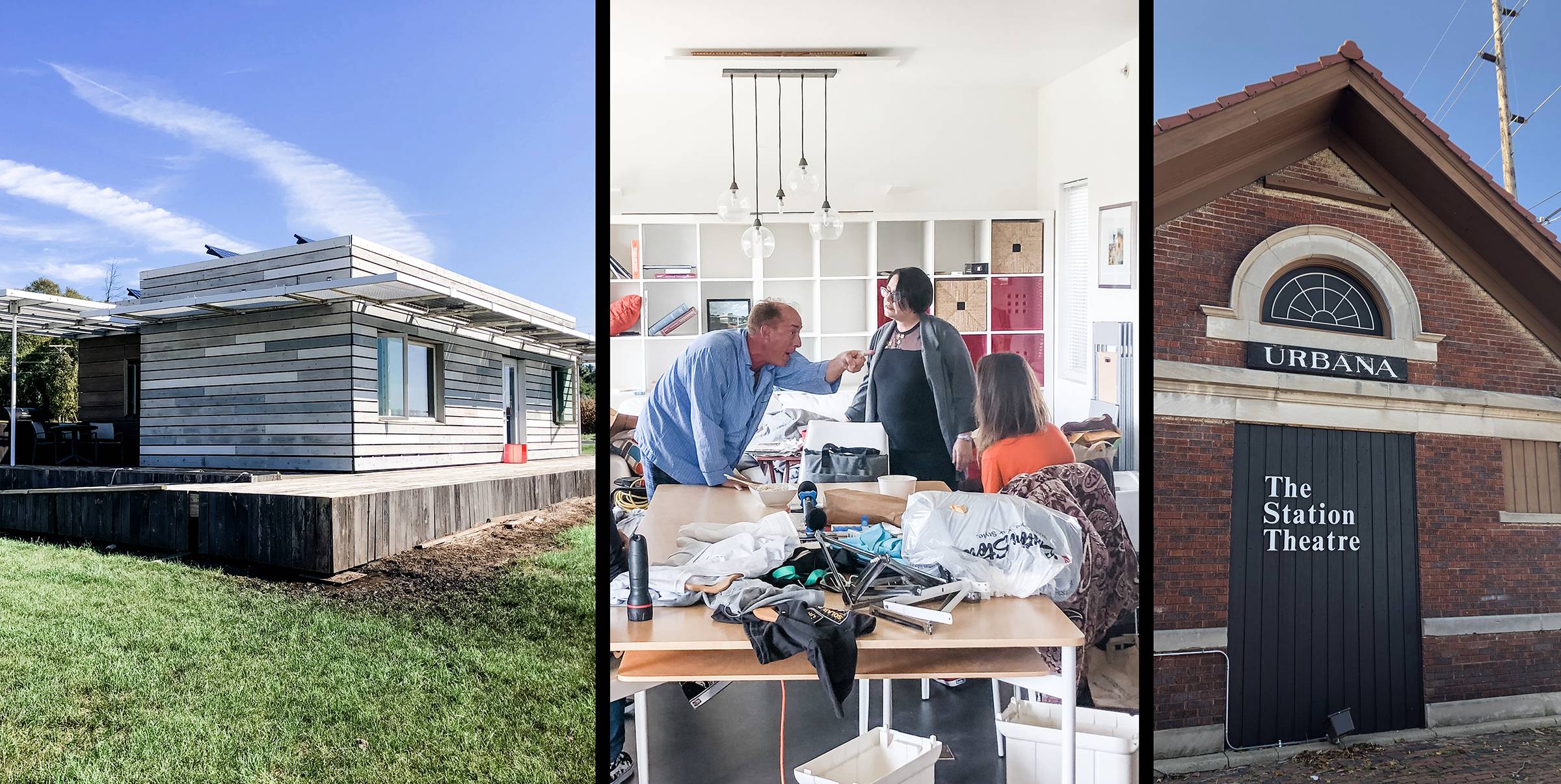Have you ever wondered what goes on inside that slick little structure across from Yankee Ridge in Urbana? Known as Re_Home, it started life as the University of Illinois entry in the 2011 Solar Decathlon hosted by the U.S. Department of Energy. Built on campus, disassembled and trucked to The Mall in Washington D.C., it placed 7th among 19 entries from across the world.
Re_Home was relocated to South Race Street and is ready and available to campus units who might have use for a dandy little house. It’s a net zero+ solar-powered masterpiece, fully furnished, complete with kitchen appliances, bathroom and flexible floorplan, depending on need. It’s connected to the grid and consistently makes more energy than it uses.
This gem of a “home” caught the interest of faculty in the School of Social Work, who were interested in developing a simulation lab for home visits for their graduate students. They were intrigued by a number of models, including one at OSF in Peoria and Caleb House at the U of I Springfield, which serves the Department of Children and Family Services.
Nothing in a classroom can prepare a student for the adrenaline-producing experience of locating an address, walking up to an unknown client’s house, ringing the doorbell, and entering as a stranger. Even before going inside, a social worker must be alert to signs that will help paint a full picture. Is there a neat garden or beer cans overflowing the recycling bin? Welcome mat or neglected toys in the yard? Anything unusual? This astute scrutiny continues inside. It’s the professional’s job to evaluate surroundings and interactions, encourage openness, build trust, and be alert to the subtleties of the home environment. Their assessment will lead to recommendations for social support services and interventions if necessary.
MSW Program Director Teresa Ostler was very interested in the idea, along with faculty Valerie Cintrón, who teaches clinical skills, and Kevin Poh Hiong Tan and Rachel Garthe who co-teach a research course. In their professional experience, they have all walked into uncertain surroundings and the occasional need to de-escalate volatile situations. They know the value of creating as realistic a situation as possible that will confront students with surprising challenges.
The faculty are familiar with simulation labs on other campuses, but most are limited. They are typically staged in a classroom building with other students acting as clients. The U of I group wanted to make it real, with an unfamiliar home and location, and actors capable of the range of possible reactions from formality to reluctance to distress and beyond.
This requires an off-site location, available to be furnished with props for a variety of scenarios. They investigated Re_Home, which is part of the Department of Agricultural and Biological Engineering, its use overseen by Prof. Xinlei Wang. Innovative design invites innovative uses. Wang appreciated the academic value of the project. The team visited, found it was perfect, and started planning.
One more piece was necessary — actors with the skill to make the scenes real. The Station Theatre was the perfect contact; actors Emily Venezia and Grant Morenz were up for a challenge, and the cast was complete.
The faculty developed two different scenarios with several scenes each. For the first, a social worker for a rural health facility visits Ms. Alicia, 28-year-old mother of a 6-year-old son. His teacher was alerted by a conversation where Ms. Alicia mentioned stressful events and crying spells, fatigue, and difficulty with routine tasks. The family has been recently uprooted due to her husband’s new factory job. It requires long hours, putting more pressure on the mom. He is frustrated with her frequent oversleeping and lack of energy so that their son is often late to school.
The set was assembled with some ingenuity and careful attention to detail. At the initial visit, the visiting students pass by an accumulation of empty beer cans on the front porch and must step over a pile of dog poop (fake). Once inside, there’s general clutter and more beer cans on the kitchen table. And yes, there is a dog — a large one. The mother talks readily about her difficulties, and expresses anger at her husband and her isolation in a new community. The scenes progress to loud confrontations between the parents.
 Photo by Becky Ponder
Photo by Becky Ponder
The second scenario introduces Mr. Brown, 66, just released from the hospital. He is recently retired, and experiencing depression and other physical difficulties. He shows signs of being a hoarder; this set assembles clutter on every surface with narrow paths through piles on the floor. Pills bottles litter the table, along with a gun lock and switchblade knives. There is an initial visit for general assessment; in the second scene his daughter visits, with visible tension. She spends considerable time in the bathroom and emerges in much better spirits, at which point her father accuses her of stealing his meds. They are off and running with free-flying accusations.
Actors Venezia and Morenz nimbly adapted to the different roles. They were prepped with detailed descriptions of their characters and the situations, but no script; they made up their lines as they went. Morenz has previously acted in law school scenarios and knows the satisfaction of seeing students grow from the experience. Venezia herself has made home visits and encountered challenging situations. She particularly enjoys giving feedback to the students.
Not only did some fifty students get in-person experience; Social Work’s Assistant Director of Information Technology Tony Hillen was ready and able to act as videographer, live stream the event for remote viewing, and provide videos for later study. I watched, on the edge of my seat as conflicts erupted and the students had to react.
 Professors Tan and Garthe with students. Photo by Becky Ponder
Professors Tan and Garthe with students. Photo by Becky Ponder
De-briefing and feedback bring things back to the safety of a simulation. Everyone participated, students, actors, and faculty. Some student comments: “Great reminder to stay at the client’s level and remain calm.” “I learned that anything can happen in a home situation.” “I learned to be alert to the environment. My group was the one that had the gun lock on the table without the gun. I missed this and it was very impactful on me.”
 From left: Ostler, Hillen, Tan, Cintrón, Garthe, Venezia, Morentz. Photo by Cope Cumpston
From left: Ostler, Hillen, Tan, Cintrón, Garthe, Venezia, Morentz. Photo by Cope Cumpston
The Social Work team sees other potential uses for this kind of simulation lab. They are developing additional scenarios, with plans to include police. They will present the cues for suicide risk or the makings of a meth lab. They would like to work with other departments to share the experience and value of the work.
So, it takes a Solar Decathlon, an unusual academic inspiration, and a community theatre to brew up an innovative and effective simulation lab. Never underestimate the resources, and the creativity, of Champaign-Urbana.
A bit more about Re_Home:
 Courtesy of the Department of Agricultural and Biological Engineering
Courtesy of the Department of Agricultural and Biological Engineering
Since 2002, the U.S. Department of Energy has sponsored bi-annual Solar Decathlon competitions with the general brief to design, build, and operate a cost-effective, energy-efficient, and attractive solar-powered house. Part of the goal is to design housing readily delivered and assembled after tornadoes and other natural disasters. The U of I team came up with a net-zero model that provides flexible floor plans to suit both the physical and emotional needs of people in crisis. They proposed distribution hubs across the country that could supply houses ready to occupy within 24 hours — houses with elegance, affordability, and efficiency. To make it even better, once Re_Home found its permanent location Prof. Wang and students were awarded a 2014 grant from Students for Environmental Concerns to landscape the site with low maintenance native plants, vegetables, edible herbs, and fruit trees. It’s frequently used by student clubs, and tours to demonstrate energy efficiency.








